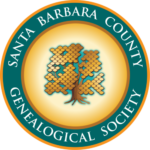Exhibit: Santa Barbara Asian American & Pacific Islander Heritage, 1870s-1970s
Joe Itsuki Mori (1923-2009) and Emily Kikuye (“Kikkie”) Nomura Mori (1920-2010)
• Gardener and Nurseryman
• Active Community Volunteers
• Specialists in Japanese Antiques
By Paul Mori, Melinda Yamane Crawford, and Mary Hancock
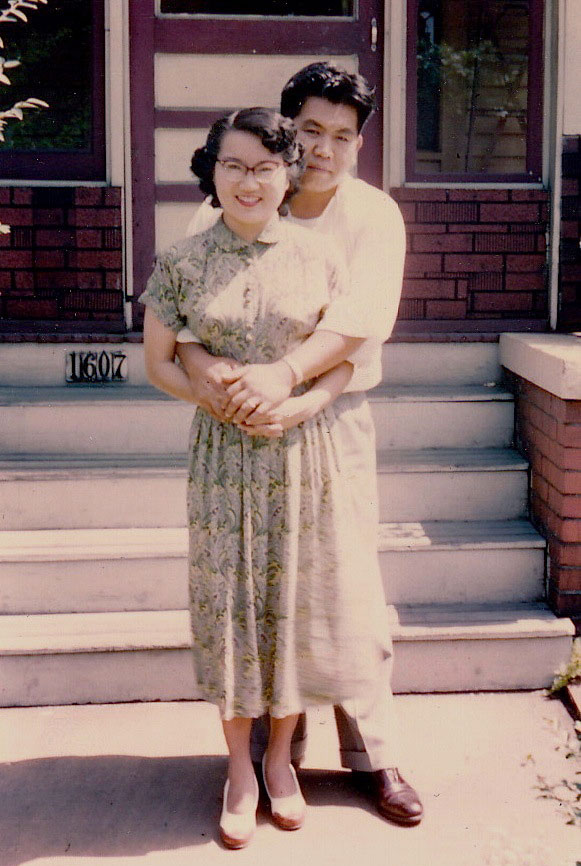
Newlyweds Kikkie and Joe Mori, 1950 (Courtesy of Forrest and Paul Mori)
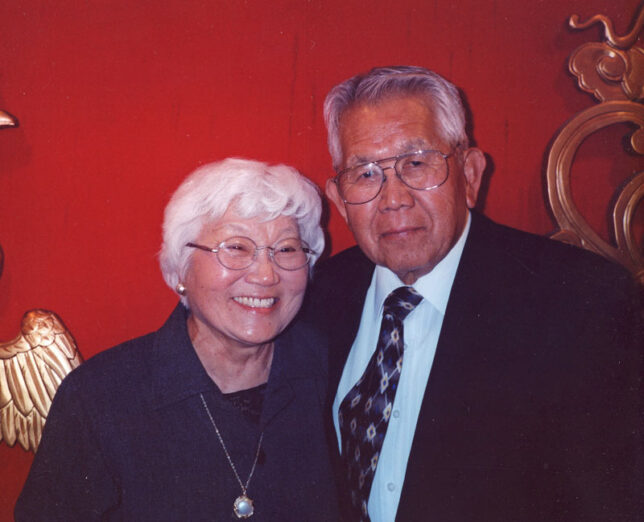
Kikkie and Joe Mori at Joe’s 77th birthday, 2000 (Courtesy of Paul Mori)
Joe Itsuki Mori and Emily Kikuye (“Kikkie”) Nomura met in Santa Barbara in 1948, married in 1950, and were the parents of two sons, Forrest and Paul. They remained in Santa Barbara throughout their long-married life, known to many for their entrepreneurial ventures and generous community spirit.
Even before their lives intersected in 1948, however, their paths had many parallels – from early years in farming families (for Kikkie, in the Imperial Valley and for Joe, in Santa Barbara) through educations interrupted by World War II and detention with their families in Arizona, in the Gila River Relocation Center (Joe) and in the Colorado River War Relocation Center near Poston (Kikkie).
The Mori Family’s Beginnings
Joe was the third of four children born to Saichi Mori and Sadame Yamauchi Mori. Saichi, born in Kamota, in Japan’s Kumamoto Prefecture in 1880, immigrated to the United States through Hawai’i, and arrived in California in 1902. His marriage to Sadame in 1918 was conducted in Japan, and she joined him in California in 1919. Saichi’s son, Frank, recalled that the marriage was arranged through the “picture bride” system common at the time. Joe remembered that the family resided on Kowalski Street on Santa Barbara’s Westside and that they later moved to a farmstead at 1917 Cliff Drive near the site of the current Lazy Acres grocery store. There, they cultivated vegetables and flowers for regional markets. Their first child, Frank Sadao, was born in 1920; followed by Satori (“Sat”) Satoru in 1922 and Joe Itsuki in 1923. A sister, Yoshiko (“Yo”) Jean was born in 1929.
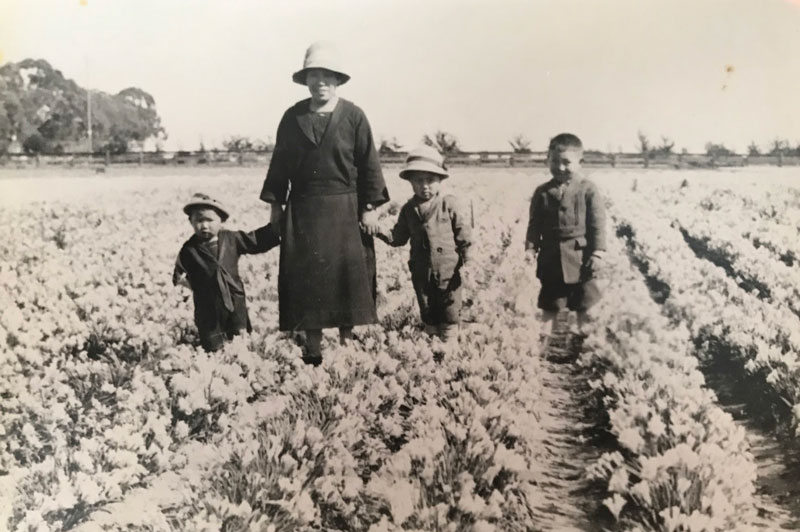
Sadame Mori and her sons walking among their field of freesias on the Mesa (Courtesy of Paul Mori)
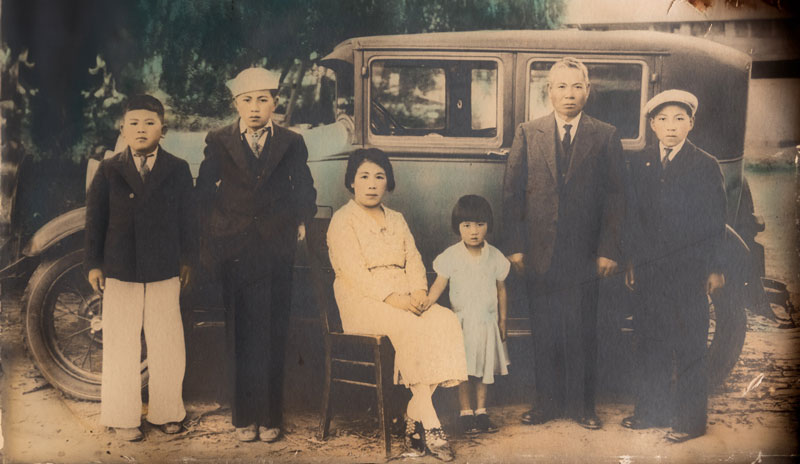
The Mori family and their car on the Mesa, 1930s. From left to right: Joe, Sat, Sadame, Yo, Saichi and Frank. (Courtesy of Forrest and Paul Mori)
Joe and brother Frank remembered childhoods filled with community activities, such as church-organized sports teams and holiday celebrations, along with work on the family farm and school. The Mori boys began their educations on the Mesa at a one-room schoolhouse before being transferred first to Wilson Elementary School and later to McKinley Elementary School after it opened in 1932; only Jean Yoshiko started school at McKinley Elementary School. They went on to Santa Barbara Junior High and High Schools and enjoyed school and home lives that were enriched by the ethnic diversity of Santa Barbara’s local community. Joe graduated in 1941 and had just started college at Santa Barbara State Teachers College when the United States entered World War II.
The Nomura Family History
Kikkie, the oldest of three children, was born near the United States-Mexico border in Brawley, California. Her father, Hisakichi Nomura, had been born in Hiroshima Prefecture in Japan in 1887. After numerous unsuccessful attempts to enter the United States, he arrived in 1907 and joined his elder step-brother, Masaichi Charles (“Charlie”), in Pasadena. In 1915, he was joined by his wife, Tsuchiyo. They moved south to the Imperial Valley, residing in several different towns as they pursued farming, with Hisakichi working as a self-employed truck farmer and later as a farm manager. Kikkie’s birth in 1920 was followed by the arrivals of Dorothy Hisaye and William Tatsuro. Like Joe, Kikkie remembers her early life as one enriched by the diverse ethnic communities who had settled in the Imperial Valley and by the lifelong friendships that she made with Japanese and non-Japanese youth. She graduated from Calexico High School in 1938 and was enrolled in El Centro Junior College when the United States entered World War II.
World War II: Incarceration and Military Service
The disruptions of the war – both the racial prejudice they encountered and their families’ forced detention – changed the courses of Joe’s and Kikkie’s lives profoundly. Soon after the declaration of war, Japanese Americans were subject to curfews and to seizures of personal property deemed suspicious, such as radios and firearms. Because of its location near Santa Barbara’s lighthouse, the Mori family home was among those searched. And, with the issue of Executive Order 9066 requiring the incarceration of Japanese Americans on the west coast, both the Mori and Nomura families were forced to leave their homes and possessions. The Moris were forced to resettle temporarily in the regional assembly center at the Tulare Fairgrounds, where nearly 5,000 persons were housed in hastily constructed barracks. The Nomuras were sent directly to the Colorado River Relocation Center, known as Poston Camp I, in Western Arizona. Each detainee was allowed two small suitcases of personal items; all other property was either requisitioned or left in the care of neighbors and community organizations, though much was lost or stolen over the course of the war. In September of 1942, the Moris were transported with thousands of other families to the Gila River Relocation Center in Central Arizona. It was there at the Gila River center that Frank Mori married his future wife, Misao, after having met her first at the Tulare Assembly Center, falling in love and together carrying their love over to Gila.
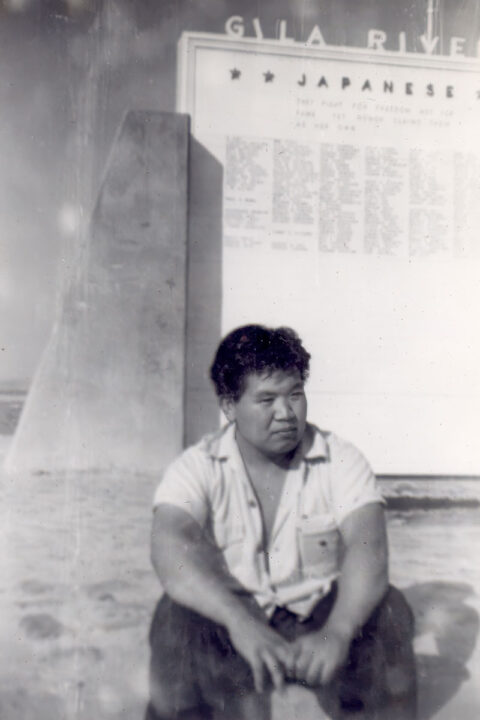
Joe Mori, Gila River Relocation Center, Gila, AZ (Photo courtesy of Forrest and Paul Mori)
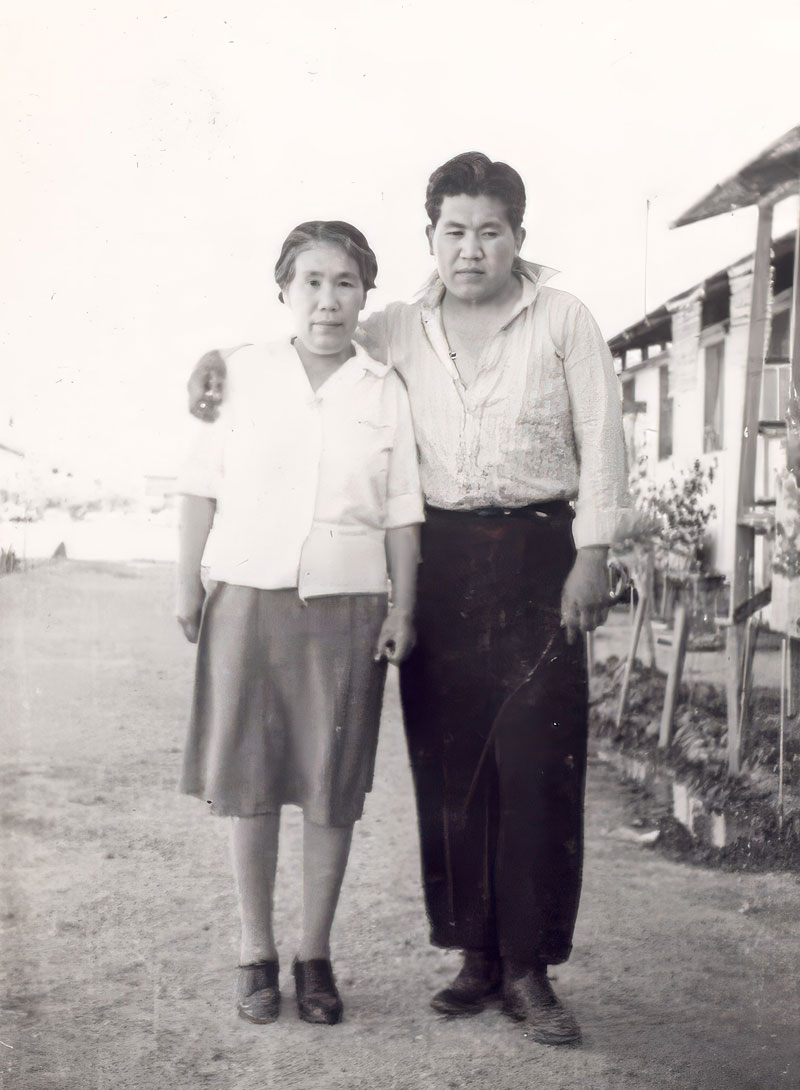
Sadame and Joe Mori, Gila River Relocation Center, Gila, AZ (Photo courtesy of Forrest and Paul Mori
Both Joe and Frank were released from camp prior to the end of the war. Frank volunteered for military service soon after arriving at Gila River, volunteering for the Military Intelligence Service (MIS) in November 1942, serving with the 77th Infantry Division based in Hawai’i and later in the U.S. occupying force on Hokkaido. During his service with the 77th Infantry Division, MISer Frank not only served as an interpreter but also accompanied front-line combat units on several island-hopping invasion campaigns, including the invasions of Guam; Leyte, Philippines; and Okinawa.
In 1943, Joe applied to live and work outside the exclusion zone and was allowed to relocate to Cleveland, Ohio. In 1944, he was drafted into the Army. Joe completed infantryman training in February 1945, and then subsequently received additional certification in July as a Heavy Mortar Crewman. He was due to be deployed in Europe. However, when victory in Europe was declared in 1945, he was sent to Military Intelligence School and later served in the Army Occupation Force in post-war Japan.
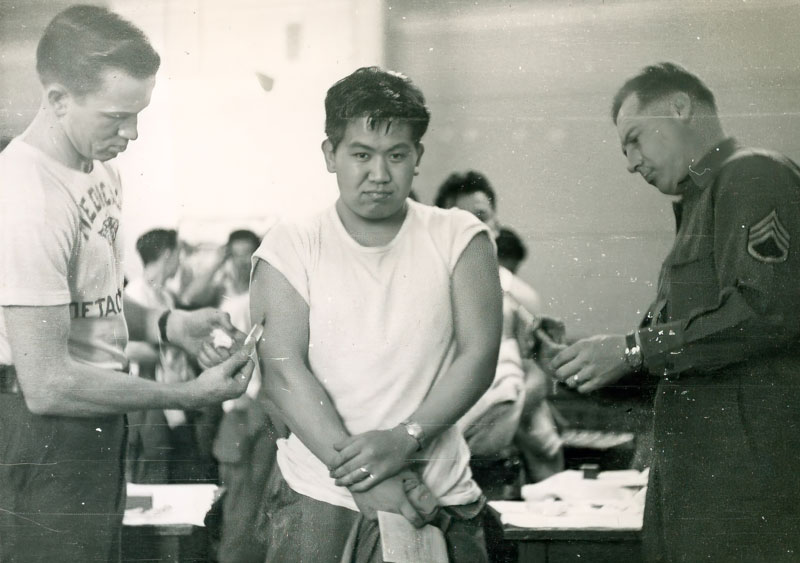
Joe Mori, WWII Army Induction (Courtesy of Forrest and Paul Mori)
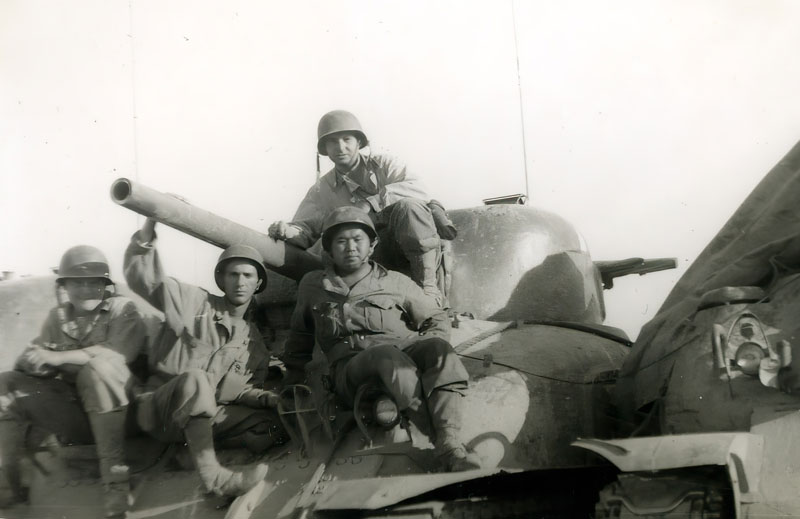
Joe Mori, Armored Replacement Training Center, Fort Knox, KY, 1945 (Courtesy of Forrest and Paul Mori)
During the Nomura family’s detention at Poston, Kikkie applied her clerical skills to jobs as an Assistant Block Manager and later as a typist at the camp’s warehouse office and in its administrative office. Kikkie remembered the intensity of both winter cold and summer heat in the desert, and its severe dust storms, as well as the movie and dance nights that punctuated their weeks.
Through the years in detention there were diversions such as sports and dances, and opportunities to forge friendships with other Japanese Americans; but the overall experience was one of privation, despair, and humiliation. As Joe shared in a lecture that he gave in 1998, he used the term “concentration camp” to describe the detention site: “24 hours a day we were watched by the soldiers in the guard towers… they were armed with machine guns. We were told that this was for our protection from outside harm, but why were the guns always pointed inwards at us?”
Intersecting Lives
Both families were released in 1945. The Moris returned to Santa Barbara. Despite trying to reassemble their pre-war lives, with their farms gone and in the hands of others, it was impossible. Joe joined them in 1947 after his discharge from the army, at which point they lived on Hollister Avenue. The Nomuras went first to Downey, near Los Angeles, where Hisakichi sought any available work. Kikkie and her sister, Dorothy, took on domestic work, as housecleaners and helpers; and younger brother William completed his high school education. The Nomuras soon relocated to Santa Barbara, following the offer of a position to Hisakichi on the Avery Brundage estate in Montecito. The family lived in a caretaker’s house on the property. Kikkie found clerical work and also participated in Japanese American community events, including the Christmas hayride where she met Joe in 1948.
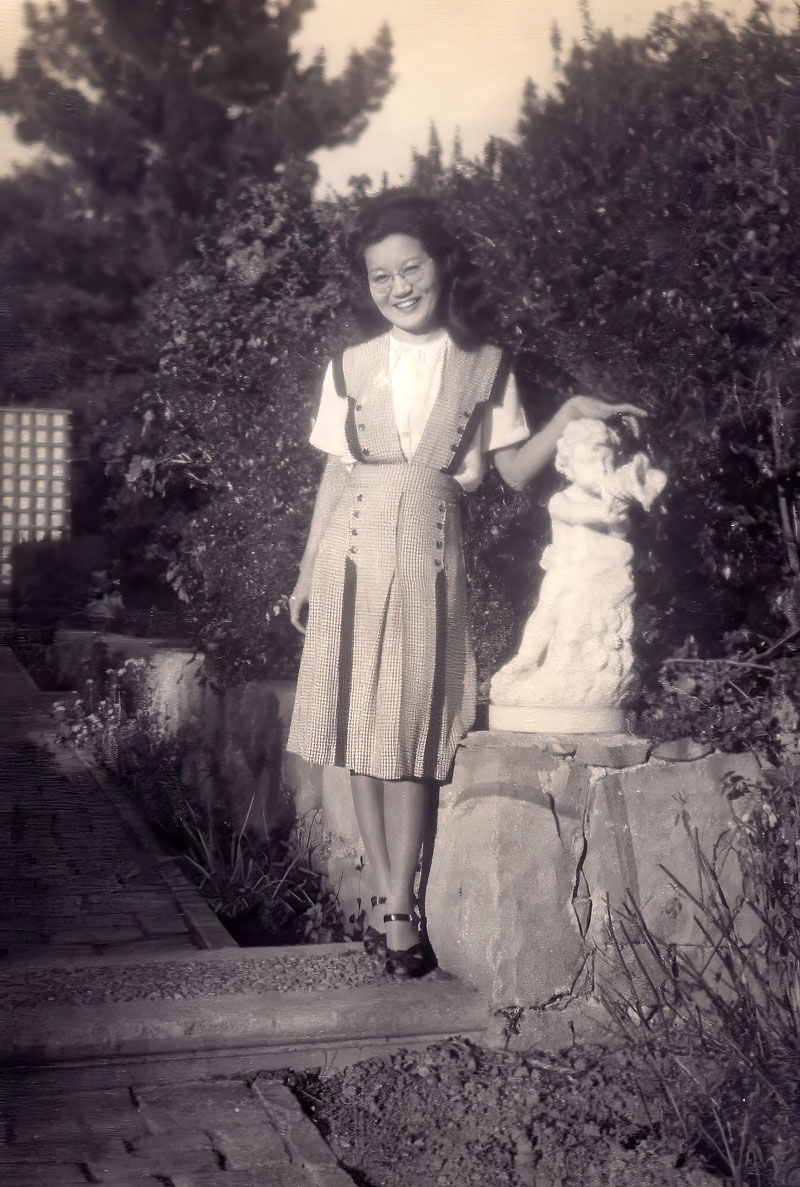
Kikkie Nomura at the Avery Brundage Estate (Photo courtesy of Forrest and Paul Mori
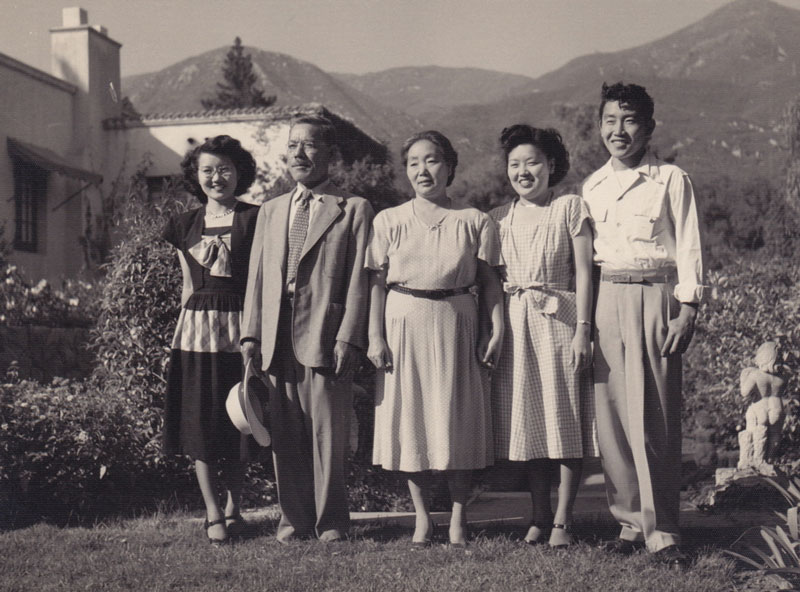
The Nomura family at the Avery Brundage Estate. From left to right: Kikkie, Hisakichi, Tsuchiyo, Dorothy, and William Nomura (Photo courtesy of Forrest and Paul Mori)
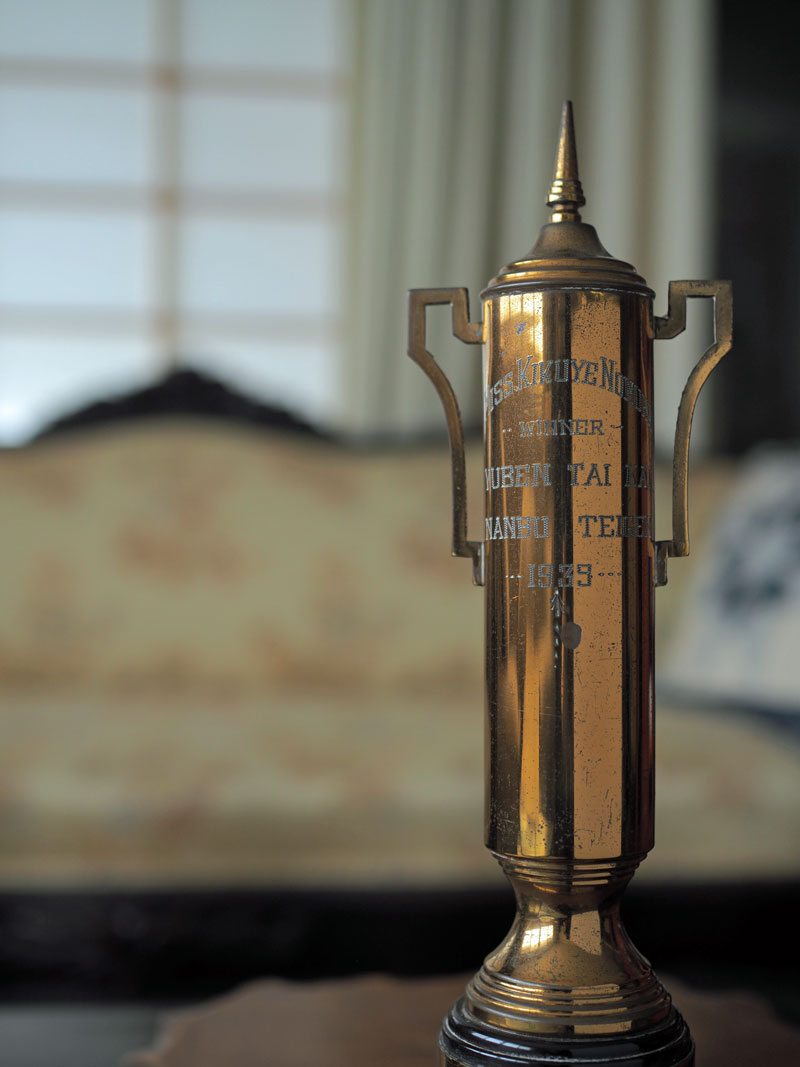
Kikkie’s Japanese language speech “winner” trophy, Yuben Tai Kai, Nanbu Teigen, 1939 (Courtesy of Paul Mori)
Joe and Kikkie were married in 1950 and built a new life in Santa Barbara. The racism that had surged during the war years, however, continued to resurface periodically, such as when they were repeatedly turned away from apartments they sought to rent. They were able to save enough money to purchase a plot of land where they built a house. In 1952, their first son, Forrest, was born; he was joined by brother Paul in 1955. Both boys were educated in Santa Barbara schools and went on to Westmont College. Forrest pursued further study in Cognitive Psychology at Bowling Green State University in Ohio, returning to Santa Barbara County where he worked with enterprise resource planning at QAD, preceded by work with business information systems at manufacturing companies based in Goleta. In addition to Forrest marrying the love of his life, Priscilla, in 1977, Forrest and Priscilla’s daughter, Sarah, was the pride and joy of Joe and Kikkie. Paul found his calling in music and, after earning graduate degrees in Music at the Peabody Institute of The Johns Hopkins University (Baltimore) and teaching in the Pacific Northwest, he returned to Santa Barbara. He is now on the faculty at Westmont College and serves as music director of the Santa Barbara Prime Time Band.
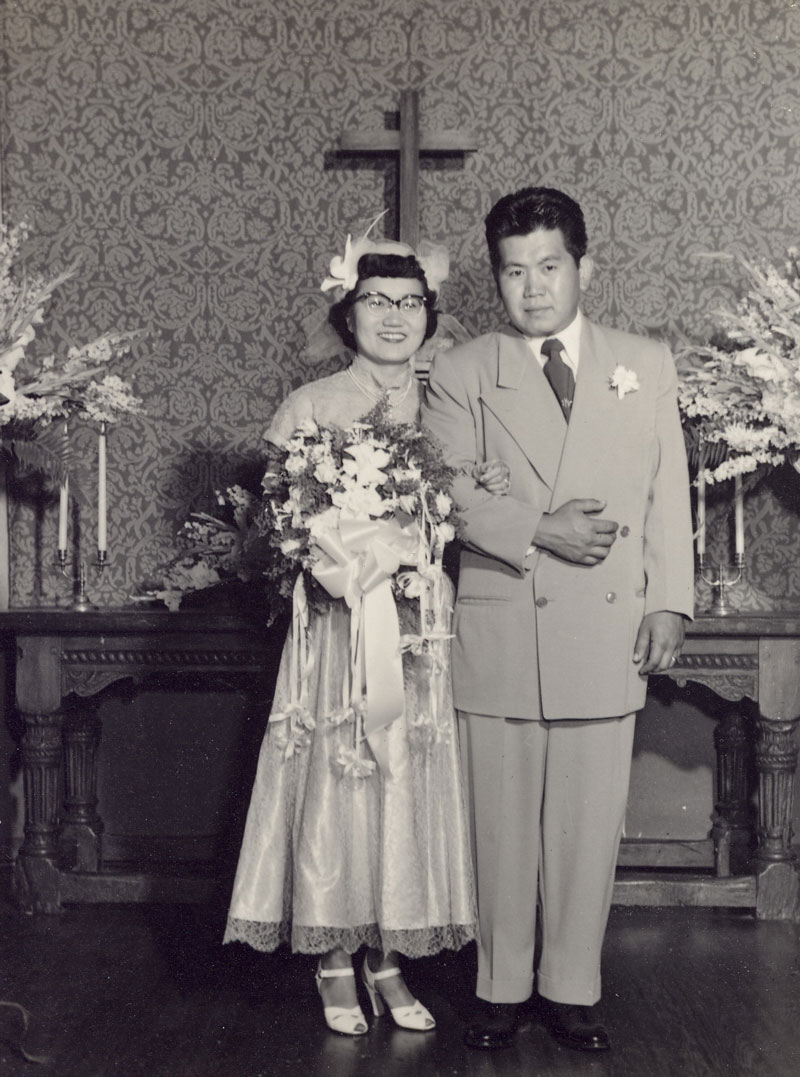
Kikkie and Joe’s Wedding Photo, El Monte Presbyterian Church, 1950 (Courtesy of Forrest and Paul Mori)
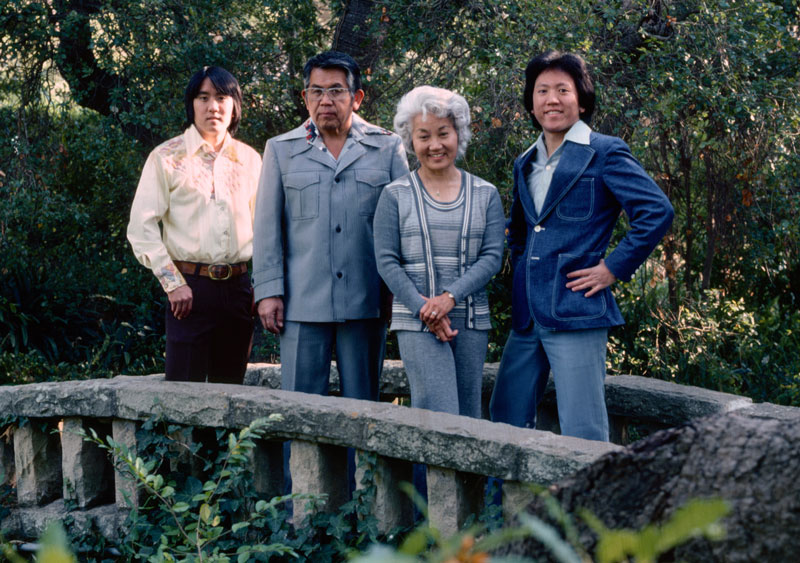
Paul, Joe, Kikkie and Forrest Mori, Westmont College, 1976 (Courtesy of Forrest and Paul Mori)
Joe and Kikkie’s post-war life in Santa Barbara was built on their families’ pre-war achievements. Joe’s background in farming and landscaping led to his partnering with brother Frank and a third partner to found and run the Kata Shi Nursery in Goleta. After retiring from the nursery in 1979, Joe and Kikkie pursued their interests in Japanese antiques as independent dealers. They were also able to visit Japan on several occasions, where they renewed family ties in both Kumamoto and Hiroshima prefectures. They continued to practice the generosity that they were both brought up to value – as volunteers for Meals on Wheels for 25 years, as active congregants of local churches – and to embrace the diversity that they learned to cherish as children while bearing witness to new generations about racism’s traumatic toll. As son Paul noted, his parents like others of the Nisei generation were reluctant to open up about their wartime experiences until late in life. It was in the 1990s that Joe more fully shared his story in lectures to Westmont College classes and that Kikkie wrote an autobiographical narrative. But, for both, revisiting those memories was sometimes painful.
Reflecting on his parents’ lives and their reckoning with the injustices of racism, Paul acknowledged the importance of the court battles in the 1980s, which had led to reparations for the Japanese Americans incarcerated during the war (signed into law under President Reagan), followed by an official apology from President George H. W. Bush. While the wrongs of the past could not be erased, the letter of apology was a turning point for many of the Nisei generation, despite coming late in their lives. In his letter to the editor of the Santa Barbara News Press (October 4, 1990), Paul observed that “the reparations corporately recognize that America’s ‘relocation camps’ served only to assuage the prejudicial fear of the few, at the cost of ruinous destruction of the lives and dignity of a great many Americans of Japanese descent.” He considers it the responsibility of his generation to speak for the community, and in open forums, in his teaching and in other voluntary endeavors, Paul has continued to do just that, carrying his parents’ legacy and values forward.
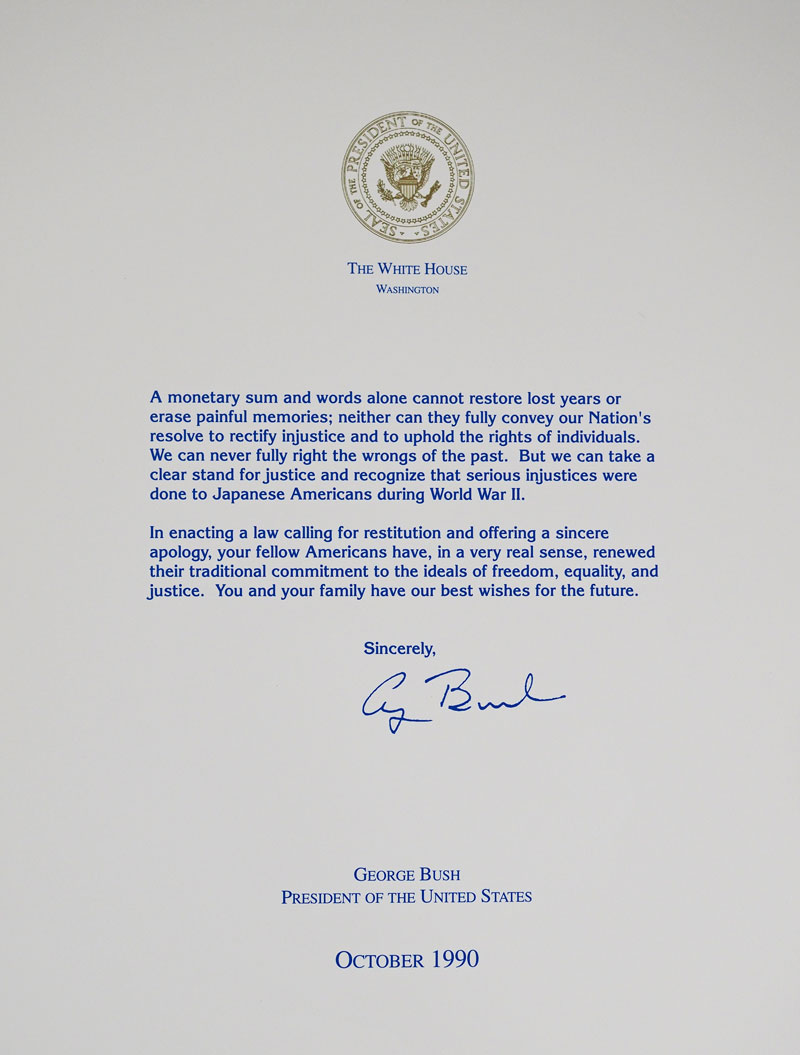
Paul, Joe, Kikkie and Forrest Mori, Westmont College, 1976 (Courtesy of Forrest and Paul Mori)
References
Websites and Blogs:
“Biographies of People at Poston- One of America’s Concentration Camps. “Mori, Kikiye[sic] Emily Nomura, Poston Block 54-8-A. Poston Community Alliance. https://postoninterneeobituaries.blogspot.com/2011/10/kikuye-kikkie-emily-nomura-mori-1920.html
Accessed February 19, 2023.
Mori, Frank Sadao. Personal Narrative (4 pp). National Park Service Collections. (https://www.nps.gov/articles/000/frank-mori.htm). Accessed August 29, 2023.
Mori, Frank Sadao. Oral History Interview (45 pp). Go for Broke National Education Center Oral History Project. Recorded August 18, 2006, Ventura California. Archived on the Japanese American Military History Collective Website. Accessed August 29, 2023. https://ndajams.omeka.net/items/show/1053452
Periodicals:
Craig, Scott. “The Silent Generation.” The Westmont Magazine, Spring 2024, Vol. 43, No. 1, pp. 19-24.
Mori, Paul. “Joe Itsuki Mori. “ Santa Barbara Independent, August 20, 2009, p. 25.
Government Records:
United States Department of Justice, Immigration and Naturalization Service. Alien Registration File for “Saichi Mori.” File Number A2 248 943 NS DJ. National Archives and Records Administration, Kansas City, Missouri.
Databases accessed through Ancestry.com and FamilySearch.org:
“Mori, S.” 1923. Dana Burks’ Santa Barbara City Directory. 1921, 1922-24, 1926. In “United States City and Business Directories, ca 1749-ca. 1990” Database available through FamilySearch.org (https.//familysearch.org). Accessed 20 April 2024.
“Honolulu, Hawaii, U.S., Arriving and Departing Passenger and Crew lists, 1900-1959,” Entry for Hisakichi Nomura (1907). Digital image, Ancestry.com, (https://www.ancestry.com), Provo, UT. Accessed 3 Mar 2023.
United States of America, Bureau of the Census. Fourteenth Census of the United States, 1920. Brawley, Imperial, California, sheet 13B, Hisakichi Nomura. Digital images, Ancestry.com (https://www.ancestry.com), Provo, UT. Accessed 6 Mar 2023.
United States of America, Bureau of the Census. Fifteenth Census of the United States, 1930. Silsbee, Imperial, California, Page 12A, Hisakichi Nomura. Digital images, Ancestry.com (https://www.ancestry.com), Provo, UT. Accessed August 30, 2023.
United States of America, Bureau of the Census. Fifteenth Census of the United States, 1930. Santa Barbara, California, sheet 6A, Saichi Mori. Digital images, Ancestry.com (https://www.ancestry.com). Provo, UT. Accessed 17 Mar 2023.
United States of America, Bureau of the Census. Sixteenth Census of the United States, 1940. Judicial Township 6, Imperial ,California, sheet 2A, Hisakichi Nomura. Digital images, Ancestry.com (https://www.ancestry.com). Provo, UT. Accessed 28 August 2023.
United States of America, Bureau of the Census. Sixteenth Census of the United States, 1940. Santa Barbara, California, sheet 7A, Saichi Mori. Digital images, Ancestry.com (https://www.ancestry.com) Provo, UT. Accessed 17 Mar 2023.
United States of America, Bureau of the Census. Seventeenth Census of the United States, 1950. Santa Barbara California, sheet 11, Saichi Mori. Digital images, Ancestry.com (https://www.ancestry.com). Provo, UT. Accessed 17 Mar 2023.
United States, Selective Service System. “Hisakichi Nomura,” Selective Service Registration Cards, World War II: Fourth Registration for the State of California, Records of the Selective Service System, Record Group Number 147. National Archives and Records Administration. Digital image, Ancestry.com. U.S., (https://www.ancestry.com). Lehi, UT. Accessed 28 August 2023.
United States, Selective Service System. “Saichi Mori,” Selective Service Registration Cards, World War II: Fourth Registration. Records of the Selective Service System, Record Group Number 147. National Archives and Records Administration. Digital image, Ancestry.com. U.S., World War II Draft Registration Cards, 1942 [database on-line]. Lehi, UT. Accessed 28 August 2023.
United States, Selective Service System. “Saichi Mori.” World War I Selective Service System Draft Registration Cards, 1917-1918. Washington, D.C.: National Archives and Records Administration. M1509, 4,582 rolls. Digital image, Ancestry.com (https:// www. ancestry.com) Provo, UT. Accessed 28 August 2023.
United States, Selective Service System. “Hisakichi Nomura.” Selective Service Registration Cards, World War II: Fourth Registration. Records of the Selective Service System, Record Group Number 147. National Archives and Records Administration. Digital images, Ancestry.com (https://www.ancestry.com). Accessed 6 Mar 2023.
United States, War Relocation Authority Centers. “Final Accountability Rosters, 1942-1946,” entry for “Saichi Mori.” Japanese-American Internee Data File, 1942-1946. Records About Japanese Americans Relocated During World War II, 1988-1989; Records of the War Relocation Authority, Record Group 210; National Archives at College Park, College Park, MD. Digital images, Ancestry.com. (https//www.ancestry.com). Lehi, UT. Accessed 15 August 2023.
United States, War Relocation Authority Centers. “Final Accountability Rosters, 1942-1946,” entry for Hisakichi Nomura. Japanese-American Internee Data File, 1942-1946 [Archival Database]; Records About Japanese Americans Relocated During World War II, 1988-1989; Records of the War Relocation Authority, Record Group 210; National Archives at College Park, College Park, MD. Digital images,
Ancestry.com. (https://www.ancestry.com) Lehi, UT. Accessed 15 August 2023.
United States, World War II Army Enlistment Records, 1938-1946. “Itsuki J. Mori.” Electronic Army Serial Number Merged File, 1938-1946; NAID: 1263923; Record Group Title: Records of the National Archives and Records Administration, 1789-ca. 2007; Record Group: 64; Box Number: 10015; Reel: 63. Ancestry.com. U.S., World War II Army Enlistment Records, 1938-1946 [database on-line]. Lehi, UT, USA: Ancestry.com Operations, Inc., 2005. Accessed October 25, 2023.
Unpublished Sources:
Mori, Emily Kikuye (Nomura). N.d., “Desert Primrose.” Personal Narrative (22 pp). Courtesy of Paul Mori.
Mori, Joe Itsuki. Lecture Presented at Westmont College (7 pp). November 20, 1998. Transcription courtesy of Paul Mori.
Interviews
Mori, Paul. Santa Barbara, California. Interviews via Zoom with Melinda Yamane Crawford and Mary Hancock. 1 August 2023 and 19 October 2023.
